The A-Team ran on NBC from 1983 to 1987, and was a show that everyone watched. It was also the only time most of us ever even saw a Ruger AC-556, as Google and the consumer internet did not exist. This rifle was always at the ready and done in stainless steel with side-folding stocks. It was incredible! I always wanted to handle an AC-556, but the chance never came my way … until now 20, years after the A-Team went off the air.
History of the AC-556
The AC556 was based off the Mini-14. Ruger, Sturm& Co. began manufacturing the Mini-14 in 1974, borrowing many of its design elements from both the M1 and the M14. Bill Ruger was interested in law enforcement and military sales, and to that end he released the GB (government bayonet) model. The GB offered a plethora of unique options. It had a pistol grip, side folding stock, a 30-round magazine, bayonet lug, threaded barrel and a flash suppressor.
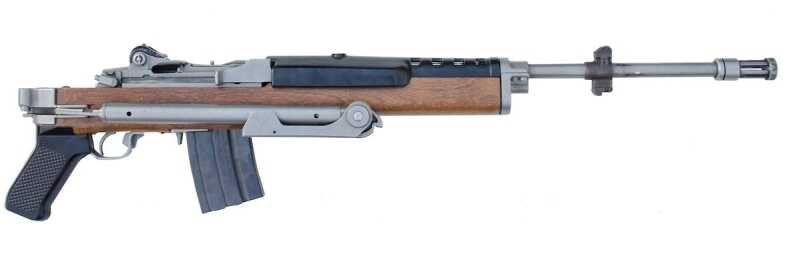
The F in the KAC-556 F indicates that it has a folding stock and the K indicates that it is a stainless steel model.
In 1979, Ruger introduced a selective-fire version of the Mini-14 called the AC-556. This gun was intended for military and law enforcement use only.
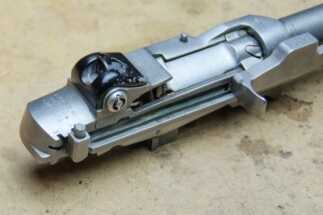
The AC-556 allows users to select three modes of fire: semiautomatic, three-round bursts and automatic.
In addition to the features of the GB, the AC-556 incorporated a selector on the right/rear of the receiver to select either semiautomatic, three-round burst or automatic fire. The barrel is capped by a flash suppressor. The manual safety remained in the front of the trigger guard. There were several models offered, and came equipped with either an 18½-inch or 13-inch barrel.
Acceptance
Neither the AC-556 nor the Mini-14 GB ever saw major success in their intended markets. As a matter of fact, they frustrated the loyal owners of the Mini-14, with features like 30-round magazines, flash suppressors, bayonet lugs and folding stocks denied to most civilians by Ruger. The largest adoption of these guns was by the American corrections market, with prisons and jails putting them into service. There were some law enforcement agencies in Florida, Ohio and Oklahoma that gave the AC a whirl, but never to the level of the AR-15 platform. Internationally, the French used the rifle in select units, as did some South American elements. However, the gun never broke into the front lines of military service, as it failed the testing. The platform was simply not accurate and could not stand up to the high round counts expected of a main battle rifle.
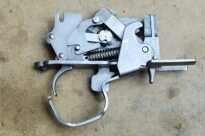
There is not a direct conversion from the Mini-14 as the AC-556’s stock is longer to accommodate a larger fire control system.
The AC-556 was doomed, as it had found no military success and the passage of the Firearm Owners Protection Act of 1986 and the Hughes Amendment forbade private ownership of new machineguns. To make matters worse, the government was allowing law enforcement to obtain used M16s for practically no cost. The AC-556’s customer pool, already quite shallow, had dried up. Sadly, the AC-556 was dropped from production in 1999, and Ruger stopped offering service for the rifle in 2009.
A Rare Opportunity
I had the chance to shoot and handle a vintage KAC-556 F, with the 18½-inch barreled machinegun. To decode the model for you, K stands for stainless-steel and F indicates that it had a folding stock. The rifle had been in public service its entire life and spent the last 20-plus years on a helicopter. This old rifle showed its age through a patchwork of scratches and dings on its stock and finish. Internally, things were in much better shape. There was only one 20-round blued magazine around when I got to fire it. As I looked the rifle over, I was impressed by the innovative the fire control system and folding stock especially for the late 1970s.
Article Continues Below
One reason that there aren’t Mini-14 conversion kits is due to the fact that the receiver is longer in the AC-556 to accommodate the fire control system. The folding stock is also a rare find in the wild. I have seen these, with complete folder stock and gas systems going for almost $1,000. There are also some aftermarket offerings, which can be identified as not original by the location of the sling swivel. Most fakes will have the sling swivel mounted on the bottom of the gas block rather than the left side.
The three-round burst is accomplished through a mechanical counting system. There is a spur on the hammer that contacts a gear with six cogs. This gear is mounted to a pin that has a wheel on the other side with two notches. When the selector is moved to the three-round burst position, a finger pushes against the wheel as the trigger is depressed and the rifle fires, causing the assembly to rotate. As the finger contacts either of the two notches it disengages the sear. When automatic is selected, the finger is pushed down and away from the wheel, allowing the gun to cycle until the trigger is released.
On the range
Getting the opportunity to shoot the KAC-556 F was like becoming a member of the A-Team. I was downright giddy. As I loaded up the 20-round metal magazine and rocked it into place in the magazine well, I was ready for an adventure.
Once the gun was loaded, I dropped the bolt to chamber a round and pushed the safety forward at the front of the trigger guard. I began by squeezing off one shot at a time to get a feel for the gun. Once I was comfortable, I selected the three-round burst and away we went. The only problem was that a few pulls of the trigger emptied the 20-round magazine quite quickly. I loaded the magazine and resumed dumping three-round burst. It seemed controllable, but the recoil impulse and climb were noticeably greater than an M16. My plan for the third magazine was a good, old-fashioned 20-round automatic magazine dump. Moving the selector to the A position, I grabbed hold tightly and depressed the trigger. The rifle was controllable … but just barely. This rifle is fun to shoot, but it does certainly make you appreciate buffers in a modern-day semiautomatic rifles. Of course, no trip to the range on an KAC-556 F would be complete without folding the stock and shooting it A-Team style. I shot some three-round burst and then the obligatory mag dump. Although the rifle did not get away from me, the only thing I was sure that I could hit was the berm. Unless in extremely close quarters, this is definitely just a Hollywood technique.
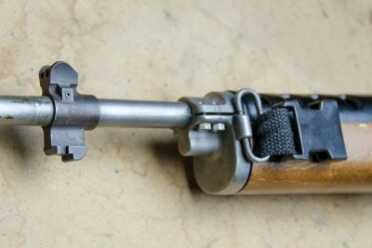
There some aftermarket options out there, but the original Ruger AC-556’s have the sling swivel on the left side of the gas block.
The Bottom Line
There are some transferable AC-556’s available; the last one I knew of went for about $6,500, and that was well over 12 years ago. I suspect that these run $10,000 plus. I understand why it lost out to the M16; the AC-556 is not a bad gun. Unlike the design process for most military arms, the civilian version was built first and then adapted to the military market. This is a shining example of why typically military to civilian adaptations produce the better firearms.
To learn more about the history of the Ruger Mini-14, click https://www.ruger-firearms.com/products/mini14RanchRifle/models.html.
To purchase a Ruger Mini-14 on GunsAmerica.com, click https://www.gunsamerica.com/Search.aspx?Keyword=Mini%2014 .

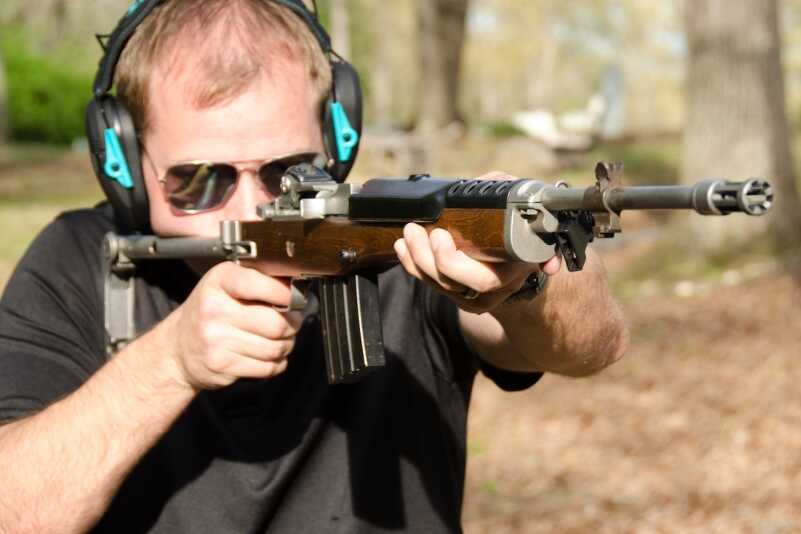
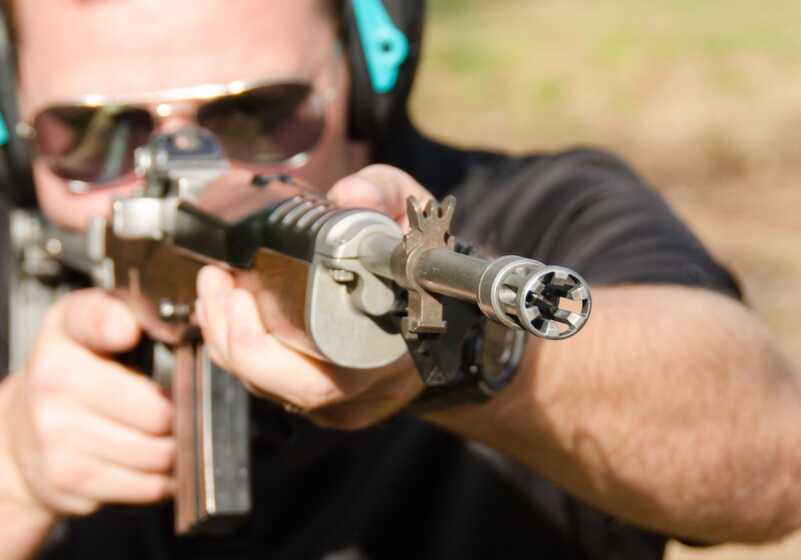
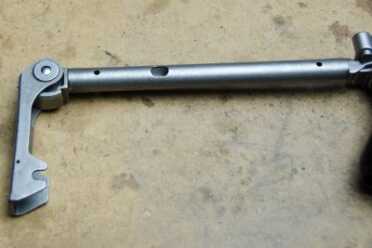
Sorry, but I cannot agree ….
A lot of AC556 have been made in te 80s, and shipped to France via Humbert Import Company in Saint Etienne. There I could see them when before dispatching.
These guns have been sold to some french police forces.
I know some guns have been shipped to english Special Forces during the same period.
All of them were not stainless steel, but black painted carbon steel made.
the xgi was produced but never made it to market. there are in fact a very small number in public hands.
ruger auctioned off one just a few years ago.
As long as BILL was alive I couldn’t even get a factory magazine for my legal gun ! Now that Bill is DEAD the company and really grown to BE A GREAT COMPANY !
CHANGE THE PENCIL THIN BARREL TO A HEAVY BARREL AND YOU WILL HAVE A GREAT GUN !
GOOD LUCK IN YOUR OVER A YEAR FORM 4 WAIT TIME OR OVER 3 MONTH FORM 3 TIME
I was in law enforcement in the early/mid 1990’s at a small town in S.E. Arkansas. We had 2 AC556’s. Both were stainless with full wooden stocks. We put a Choate folding stock on one of them. That was the one I enjoyed playing with. I would occasionally load 100 rounds & take it out. I had a lot of fun with it. It never hiccuped a single time. I would put the pistol grip just under my belly button and my weak hand on top of the ventilated handguard to hold it down. I found it quite controllable for that caliber, though the gun was not really very accurate. A 30 round mag only lasted about 1.8 seconds. Thanks for your article. It brings back old memories for an old man.
The Mini 14 was never an accurate rifle, after five rounds the bbl was so hot it strung rounds all over the countryside. I never saw one that would shoot well. They are cute and cool looking but there it ends. I know, some of you have one that holds MOI at 500 yards and i say good for you, but in my many years I never saw one do it. first shot accuracy was ok and would get the job done but after 5 it was pretty well a good club.
I have owned up to 5 mini 14,
All of which I found to be very accurate. Never had any jamming.
Liked it better than the m16 I had in the army.
Only the mags and accessory cost more.
You don’t need to dissassemble the gas block on the rifle to get the stock off. The gas block screws are staked from the factory and should never be removed unless absolutely necessary. They come apart like an M14 or M1 Garand. The action is tipped upwards and the stock is removed after the removal of the trigger group.
Wasn’t it a rifle such as reviewed herein that was used in the infamous shootout (by the “bad” guys) with the FBI, that led to the FBI adopting the 10mm short, aka .40 caliber, handgun? David Soul, as in ‘Starsky & Hutch’ (Soul played Hutch, and IIRC, said in the movie dramatizing the shootout, something like “Man, I love this Ruger”, and Michael Gross, as in ‘Family Ties’ and ‘Tremors’ (and sequels), played the bad guys.
There were some signifcant foreign police and military sales of the AC-556. too:
– The Royal Ulster Constabulary traded in its British-issue Sterling SMGs for them
– The French Interior Ministry bought them for its specialty police and anti-terror/riot forces (Police Aux Frontières, GIGN, CRS)
– The Rhodesian armed forces used them
– Hong Kong and Honduras still use them, too.
This article reminds me of a modestly expensive lesson from my youth.
In the early 80s, as a teenager who had watched more than a few hours of a-team, complete with the spectacle of immense ammo expenditure and massive destruction, but with no one so much as getting a scratch, I decided to have some fun with my new folding stock mini 14 with a few large cap magazines. I spent what was for me a fortune and bought 5 boxes of ammo (back when the dealer had to record the sale of each box), and went to our quarry rifle range. Targets were 2 dozen beer bottles at about 30-40 ft, and I opened fire shooting from the hip a-team style. I didn’t realize it at the time, but I perfectly duplicated their performance because not a single bottle had been hit with my 100 rounds.
Lesson learned: it’s not how fast one expends ammo or makes noise that counts, but how rapidly one obtains hits.
And yes, we shot beer bottles, and yes, we cleaned up the glass afterwards. We set them on saw horses over tarps, so clean up was complete and easy.
The only “pelvic thrust” firing position associated with even reasonable accuracy is the “Lebanese” position in which the rifle butt is lined up on the bone in the pelvic anatomy below the belly button and above one’s junk. This position gives you a decent chance to line up accurate shots quickly. I’ve tried it, and it’s not bad, though not as good as more conventional firing from the shoulder.
I owned a Ruger KAC-556F. The “F” was the designation for the stainless steel version. “K” was short for “kurz,” German for “short.” The rifle length version was the AC-556 for blue and AC-556F for stainless.
K does indeed stand for kurtz (short) but that is not how Ruger uses it. The K in ANY Ruger firearm designation does in fact denote stainless construction.
AC556 = blue, fixed stock
KAC556 = stainless, fixed stock
AC556F = blue, folding stock
KAC556F = stainless, folding stock
One full mag on auto and you can’t even use the sights due to the heat wave distortion off the barrel.
I’ve fired one extensively at Knob Creek.
A poor mans AR, with the accuracy of a Chinese made SKS.
UGH!
I love it when a plan comes together.
I pity the fool!
Tisk tisk. Check your spelling:
I pity da foo.
Be cool to see Ruger come out with the AC-30-SA (semi-auto).
I always liked the mini-14/30 series but never have owned one.
Today’s market has become flush with nostalgic version of famous MGs (BAR, MP40, MP44, FN249, M16, et al) so the timing is perfect for Ruger to introduce a semi-auto version of their full-auto ranch rifle.
Always one of my favorite firearms as a kid, which is probably why I now have more than one as an adult hahaha. A small bit of useless trivia for everyone… The Rugers used on the A-Team show were actually the model Mini-14K/F and were semi auto only. The show armorer added a clamp-on style flash hider with 30 and 40 round mags and then they dubbed in a full auto sound bite after they fired the rifles in each scene. If you look closely in some of the old show footage you can see the actors firing the rifles in their semi auto only mode even though the sound effects make it seem like they are machine guns, which they were not.
Having been an armorer for both the AC556 and the Mini14, along with other weapon systems; I can say that the AC556 / Mini14 were both poorly designed rifles for government/military use. The gas block routinely lost screws due to heat and vibration, unless Loctite 262 was used to secure them; the action shifted around in the stock while firing – making a repeatable shot virtually impossible; the stainless models retained heat – making strings of burst and full auto fire a literal pain; and Ruger simply had no real support for them. I learned to loathe both models then and time has not changed my opinion.
By the way, Bill Ruger never did publicly say what happened to his .308 version of the Mini14 – called the XGI.
Gary The same thing happened to the XGI as with the 1st AR 10 the barrel was to light and the gas system on the XGI to weak for the 7.62X51
Just have to point out that it is thirty years later not twenty, someone had to ; )
The Connecticut Dept. of Corrections ran these from 1997 until 2010ish with a switch to M4s. Ruger locked out the full auto setting for them, basically by adding a “nub” to the selector so full auto was locked out. Choate Machine modified a Mini 14 stock so the larger receiver fit. They weren’t a bad rifle accuracy was fine. Some were run with Gemtech suppressors which were the old design with the steel washers so it added a lot of weight to the front of the gun. Twist rate was the greatest for anything heavier than 55 grains. They weren’t easy to work on, many little parts and springs in the FCG. Also the three shot burst did not have a resetting sear so when you went into 3 shot burst you could get 1,2, or three rounds depending on where the sear engagement was set. But a decent rifle none the less, but there was no chance this was going to be a first choice over the AR platforms. These were forced on the Dept. due to contracts having to be bid on. The specs that were drawn up were AR specific but Ruger did an end around with the Choate stock and a ridiculous low price I think around $275-300 a rifle, And that included Armorers school and parts and support.
That flash-hider looks like it was labor-intensive to make. It appears to be a multi piece design that is assembled and probably welded together. The end result is something that internally resembles the much more refined (and simpler to produce) VLTOR/BCM Mod.0/1 flash hider.
…And that front sight blade! Sheesh, that looks horrible.
The flash hider is more likely a one piece investment or lost wax casting.
The flash-hider was an investment cast part. My dad was a RUGER Law enforcement distributor as well as other lines prior to his death in 1989. The AC 556 and KAC models were used by the Georgia Prison System, and GBI as well. but that was over 30 years ago. In 1964 in Vietnam the M-16 did not fair well until chrome lined barrels and cleaner burning powder was purchased by the military. Several old soldiers like me hated the M16 in those days but now retired, I own several in barrels lengths of 16 to 24 inch the 24s are stainless barrels, and they are exceptional. But I must admit I have two GB models my dad used as sales samples that are still fun and I enjoy them a lot as I do all firearms. Great story on the AC 556 and KAC556. Sold our sales samples a few years ago flowing dads death. Wish Bill R and Tom had followed up with the XGI .308. It was announced in the mid 80s catalog but never produced, I heard due to targeting problems. Springfield owns the field for the M1A1 MARKET HAVE 3 OF THEM..